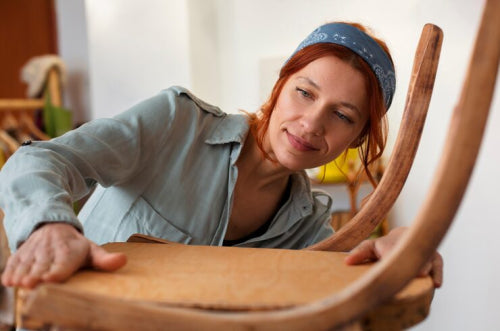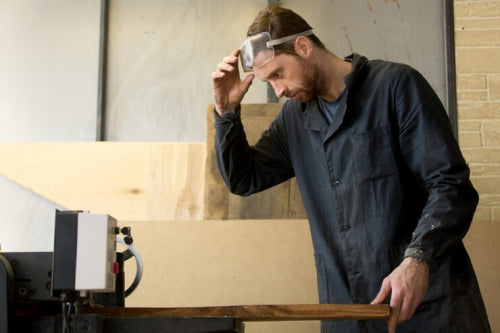In a bustling Bangalore high-rise, a sandalwood bookshelf stands proudly, its intricate carvings a quiet rebellion against the city's sleek, modern skyline. In Mumbai's crowded apartments, a teak jhoola sways, its polished arms whispering stories of generations past. Across urban India, handcrafted wooden furniture is making a bold return, transforming homes in cities like Jaipur, Chennai, Kolkata, Hyderabad, Pune, and Ahmedabad. This resurgence isn't just a trend it's a movement, driven by a hunger for authenticity, sustainability, and craftsmanship in an era dominated by mass-produced decor.
Mass-market furniture lacks heart, filling rooms with bland, short-lived pieces. Frequent breakdowns spark frustration, as replacements erode style and sentiment. At MMC Wood Creations, Udaipur artisans shape heirloom furniture with enduring craftsmanship and cozy elegance, creating pieces that echo your identity, ensuring your home radiates warmth and timeless connection. Shop Now!
The Quiet Revival of Handcrafted Wood Furniture
How urban India is embracing artisanal craftsmanship for sustainable, timeless interiors
The modern Indian home is evolving. Glass towers and minimalist interiors still dominate urban landscapes, but a growing number of city dwellers are turning to handcrafted wooden furniture to add warmth and character. In Bangalore, tech professionals commission bespoke teak room dividers that blend utility with art. In Kolkata, heritage markets buzz with young couples seeking mango wood cabinets adorned with brass inlays. According to a recent market analysis, the global home furniture sector is booming, driven by shifting consumer preferences toward sustainable, artisanal pieces that reflect cultural heritage. This revival is more than aesthetic it's a rejection of disposable culture and a celebration of India's woodworking traditions, as artisans find new audiences among urbanites craving pieces with soul.
The appeal lies in the story each piece tells. A rosewood dining table in Jaipur carries the rugged beauty of Rajasthan's deserts, while a palisander chair in Chennai reflects the city's coastal elegance. This trend is reshaping urban homes, offering a bridge between India's past and its fast-paced present. As consumers grow weary of flat-pack furniture, artisans are stepping into the spotlight, their hands shaping wood into heirlooms for a new generation.
Regional Craftsmanship Shines
India's diverse woodworking traditions give this revival its unique flavor. In Jaipur's Johari Bazaar, artisans craft rosewood and sheesham furniture, often inlaid with bone or mother-of-pearl for a touch of opulence. A local designer recently transformed a minimalist flat with a hand-carved jali screen, its latticework casting intricate shadows that shift with the sun. In Chennai, palisander pieces with clean lines and polished finishes reflect the city's understated sophistication, finding their way into coastal apartments. Hyderabad's artisans, meanwhile, are reimagining teakwood charpoys with modern upholstery, turning rustic designs into chic additions for trendy cafes and homes.
Mumbai's spatial constraints demand ingenuity. Artisans in areas like Bandra create compact, multi-functional pieces think foldable mango wood desks or modular teak shelves etched with Marathi motifs. In Ahmedabad, Gujarat's woodworking heritage favors sturdy, unadorned designs in neem and acacia, built to withstand the region's dry heat. These regional distinctions ensure every piece is unique, connecting urban buyers to India's rich craft legacy. As a February 2025 report notes, the wooden furniture market is thriving, with India's urban demand for bespoke pieces driving growth.
Sustainability and Sentiment
This revival is as much about values as it is about style. In Pune, millennials are flocking to reclaimed wood furniture, drawn to its eco-friendly appeal. A Koregaon Park workshop turns old railway sleepers into sleek coffee tables, each imperfection a badge of the wood's past life. In Kolkata, nostalgia fuels the trend, with families restoring colonial-era almirahs and teak chests. A Burrabazar restorer recounted how a 70-year-old chest, lovingly polished, became a young couple's living room centerpiece, blending heritage with modern flair.
Hyderabad's furniture scene mirrors this ethos. Artisans there use sustainable finishes like beeswax and linseed oil, appealing to eco-conscious buyers. A recent decor expo in the city showcased acacia bar carts and teak rocking chairs, all built to endure for generations. The global furniture market is seeing a surge in demand for sustainable pieces, driven by consumers who view furniture as an investment in craftsmanship and environmental responsibility. In Bangalore, sandalwood trays with minimalist designs sell out online, a testament to the city's blend of tradition and modernity.
The Artisan's Comeback
At the heart of this revival are the artisans. In Bangalore's Malleswaram, a third-generation woodworker adapts Karnataka's carving techniques to create sandalwood pieces that resonate with urban tastes. In Ahmedabad, a women's cooperative gains acclaim for hand-polished neem wood stools, each sale supporting local livelihoods. Chennai's Mylapore artisans revive Thanjavur-style marquetry, inlaying teak with vibrant veneers to craft striking accent pieces that blend heritage with contemporary appeal.
Challenges persist. Mumbai's artisans grapple with soaring wood prices and limited workshop space, while Jaipur's craftspeople face competition from mass-produced replicas. Yet innovation thrives. Kolkata's artisans collaborate with designers to create hybrid pieces, like sheesham consoles with Scandinavian lines, appealing to younger buyers. In Pune, tech-savvy craftsmen leverage social media to reach customers nationwide, bypassing traditional retail. The wooden furniture market is growing, fueled by urban demand for artisanal work, as noted in a comprehensive February 2025 analysis.
A Lasting Legacy
In India's frenetic cities, handcrafted wooden furniture offers a rare sense of permanence. A teak bench in a Bangalore high-rise, a rosewood chair in a Chennai studio, or a mango wood table in a Mumbai flat these pieces anchor homes in tradition while meeting modern needs. They're more than furniture; they're narratives, crafted by skilled hands and rooted in India's diverse landscapes. For urbanites seeking meaning in their spaces, this revival is a return to what endures.
Choosing handcrafted furniture feels like a quiet act of defiance in a world of fleeting trends. It's a commitment to quality, sustainability, and the artisans who pour their expertise into every detail. As urban India embraces this craft, these pieces do more than furnish homes they fulfill a deeper need for connection, identity, and timelessness. In a Jaipur loft or a Hyderabad cafe, the revival of handcrafted furniture is redefining what it means to live with purpose.
Frequently Asked Questions
Why is handcrafted wooden furniture becoming popular in Indian cities?
Handcrafted wooden furniture is experiencing a revival in urban India as city dwellers seek authenticity, sustainability, and craftsmanship over mass-produced decor. This movement reflects a rejection of disposable culture, with consumers increasingly valuing pieces that tell stories, reflect cultural heritage, and serve as long-lasting investments. The trend is particularly strong among millennials and young professionals who want furniture with soul and connection to India's rich woodworking traditions.
What are the regional differences in handcrafted wooden furniture across Indian cities?
Each Indian city brings unique craftsmanship styles to handcrafted furniture. Jaipur artisans specialize in rosewood and sheesham pieces with bone or mother-of-pearl inlays, while Chennai favors clean-lined palisander furniture reflecting coastal elegance. Mumbai craftsmen create compact, multi-functional pieces for smaller apartments, Hyderabad reimagines traditional teakwood designs with modern upholstery, and Ahmedabad focuses on sturdy neem and acacia furniture suited to dry climates. These regional distinctions ensure every piece connects buyers to India's diverse craft legacy.
How does handcrafted wooden furniture support sustainability?
Handcrafted wooden furniture promotes sustainability through eco-friendly materials, reclaimed wood usage, and durable construction meant to last generations. Artisans increasingly use sustainable finishes like beeswax and linseed oil instead of synthetic chemicals, while workshops in cities like Pune transform old railway sleepers into new furniture pieces. This approach reduces waste, supports local livelihoods, and aligns with the growing consumer preference for environmentally responsible purchases that view furniture as a long-term investment rather than disposable items.
Disclaimer: The above helpful resources content contains personal opinions and experiences. The information provided is for general knowledge and does not constitute professional advice.
You may also be interested in: How Interior Designers Incorporate Bespoke Wood Pieces
Mass-market furniture lacks heart, filling rooms with bland, short-lived pieces. Frequent breakdowns spark frustration, as replacements erode style and sentiment. At MMC Wood Creations, Udaipur artisans shape heirloom furniture with enduring craftsmanship and cozy elegance, creating pieces that echo your identity, ensuring your home radiates warmth and timeless connection. Shop Now!
Powered by flareAI.co




